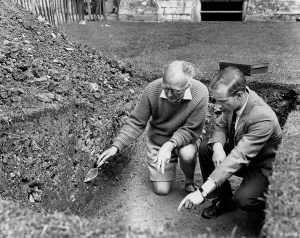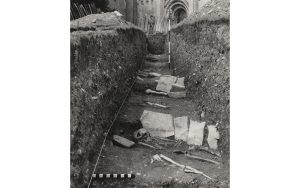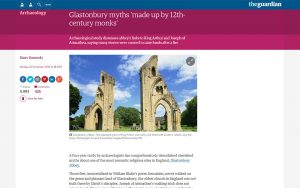Radford’s Excavation
1960s newspaper story

In the 1960s, archaeologist Ralegh Radford deliberately searched for Arthur’s grave. He used historical accounts to identify the approximate location near the Lady Chapel and began an archaeological investigation to prove the story. Radford was confident that he had found the site of the former pyramids which were said by Leland and others to have marked Arthur’s grave. He identified a nearby pit as the site of Arthur’s grave.
He believed that he could tie the pit to the exhumation date of 1191 through chippings of Doulting stone which he found mixed in the infill. Radford thought that Doulting stone was not used until the rebuilding of the Lady Chapel in 1184-9. This assumption was the basis for his dating of the pit. Archaeologists use evidence like this to establish dates before or after which something must have happened. If Radford was right, the evidence of Doulting chippings in the pit would mean it could not have been dug until shortly after the Lady Chapel was built (1184-9).
Archaeology and recent analysis
New analysis of Radford’s archaeological evidence challenges his identification of this pit as being the site of the excavation of Arthur’s grave.

Doulting stone cannot be used to assign a close date to the pit. It is now recognised as the main building material used in all phases of Glastonbury Abbey. This means the chippings could be from any date in the abbey’s history from the Anglo-Saxon period up to the Dissolution of 1539.
More significantly, beneath the pit was a cist grave (a stone-lined burial) dated to the 10th or 11th century, so the pit must be later than this date. The legendary King Arthur is believed to have died much earlier, in the 6th century, so he could not have been buried above a grave dug some four or five hundred years later.
Media responses to Arthur’s grave

The archaeological evidence does not support Radford’s claim to have found Arthur’s grave. But the Glastonbury legends developed over 1000 years and they cannot be proven or disproven by a single piece of archaeological evidence. News stories about Glastonbury Abbey often place ‘fact’ in opposition with ‘myth’, but medieval people did not see fact and myth in sharp distinction. They saw nothing wrong in adding to the bare facts with details or stories they believed to be true, or which they thought ought to be true.
Glastonbury drew upon earlier histories and legends to craft stories of its founders and fill in the historical gaps. Monks copied earlier objects and architectural styles to give these stories authenticity, because they believed they were simply recreating a lost truth. They also had a strong emotional connection with figures such as King Arthur and Joseph of Arimathea and were anxious to give these connections solid foundations and real presence.
